Astronomers using the Atacama Large Millimeter/submillimeter Array (ALMA) found a young star surrounded by an astonishing mass of gas. The star, called 49 Ceti, is 40 million years old, and conventional theories of planet formation predict that the gas should have disappeared by that age. The enigmatically large amount of gas requests a reconsideration of our current understanding of planet formation.
Planets are formed in gaseous dusty disks called protoplanetary disks around young stars. Dust particles aggregate together to form Earth-like planets or to become the cores of more massive planets by collecting large amounts of gas from the disk to form Jupiter-like gaseous giant planets. According to current theories, as time goes by the gas in the disk is either incorporated into planets or blown away by radiation pressure from the central star. In the end, the star is surrounded by planets and a disk of dusty debris. This dusty disk, called a debris disk, implies that the planet formation process is almost finished.
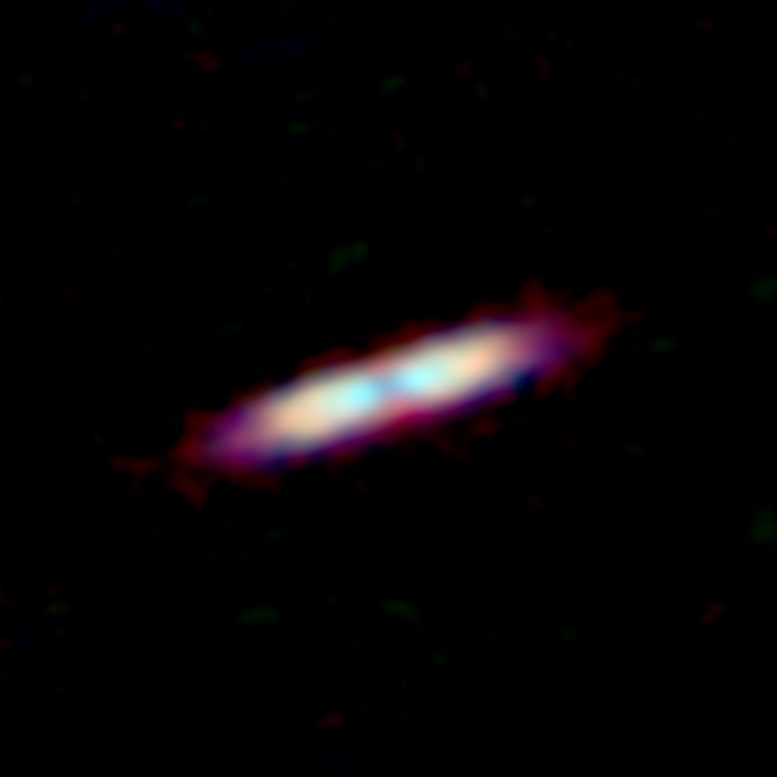
The distribution of dust is shown in red; the distribution of carbon monoxide is shown in green; and the distribution of carbon atoms is shown in blue. Credit: ALMA (ESO/NAOJ/NRAO), Higuchi et al.
Recent advances in radio telescopes have yielded a surprise in this field. Astronomers have found that several debris disks still possess some amount of gas. If the gas remains long in the debris disks, planetary seeds may have enough time and material to evolve to giant planets like Jupiter. Therefore, the gas in a debris disk affects the composition of the resultant planetary system.
“We found atomic carbon gas in the debris disk around 49 Ceti by using more than 100 hours of observations on the ASTE telescope,” says Aya Higuchi, an astronomer at the National Astronomical Observatory of Japan (NAOJ). ASTE is a 10-m diameter radio telescope in Chile operated by NAOJ. “As a natural extension, we used ALMA to obtain a more detailed view, and that gave us the second surprise. The carbon gas around 49 Ceti turned out to be 10 times more abundant than our previous estimation.”
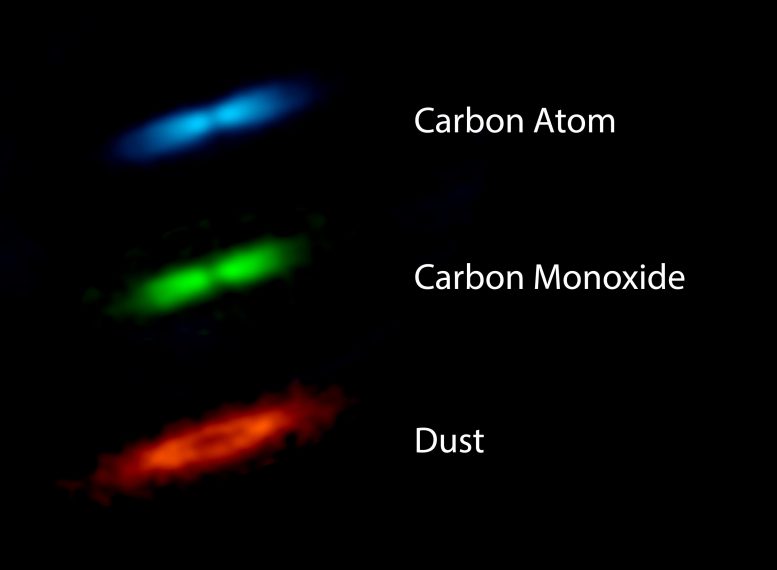
The distribution of dust is shown in red; the distribution of carbon monoxide is shown in green; and the distribution of carbon atoms is shown in blue. Credit: ALMA (ESO/NAOJ/NRAO), Higuchi et al.
Thanks to ALMA’s high resolution, the team revealed the spatial distribution of carbon atoms in a debris disk for the first time. Carbon atoms are more widely distributed than carbon monoxide, the second most abundant molecules around young stars, hydrogen molecules being the most abundant. The amount of carbon atoms is so large that the team even detected faint radio waves from a rarer form of carbon, 13C. This is the first detection of the 13C emission at 492 GHz in any astronomical object, which is usually hidden behind the emission of normal 12C.
“The amount of 13C is only 1% of 12C, therefore the detection of 13C in the debris disk was totally unexpected,” says Higuchi. “It is clear evidence that 49 Ceti has a surprisingly large amount of gas.”
What is the origin of the gas? Researchers have suggested two possibilities. One is that it is remnant gas that survived the dissipation process in the final phase of planet formation. The amount of gas around 49 Ceti is, however, comparable to those around much younger stars in the active planet formation phase. There are no theoretical models to explain how so much gas could have persisted for so long. The other possibility is that the gas was released by the collisions of small bodies like comets. But the number of collisions needed to explain the large amount of gas around 49 Ceti is too large to be accommodated in current theories. The present ALMA results prompt a reconsideration of the planet formation models.
Papers and the research team
These observation results were presented in the following papers.
“First Subarcsecond Submillimeter-wave [C I] Image of 49 Ceti with ALMA” by Aya E. Higuchi, Kazuya Saigo, Hiroshi Kobayashi, Kazunari Iwasaki, Munetake Momose, Kang Lou Soon, Nami Sakai, Masanobu Kunitomo, Daisuke Ishihara and Satoshi Yamamoto, 3 October 2019, The Astrophysical Journal.
DOI: 10.3847/1538-4357/ab3d26
“First Detection of Submillimeter-wave [13C i] 3 P 1–3 P 0 Emission in a Gaseous Debris Disk of 49 Ceti with ALMA” by Aya E. Higuchi, Yoko Oya and Satoshi Yamamoto, 8 November 2019, The Astrophysical Journal Letters.
DOI: 10.3847/2041-8213/ab518d
The research team members are:
Aya Higuchi (National Astronomical Observatory of Japan), Yoko Oya (The University of Tokyo), Kazuya Saigo (National Astronomical Observatory of Japan), Hiroshi Kobayashi (Nagoya University), Kazunari Iwasaki (National Astronomical Observatory of Japan), Munetake Momose (Ibaraki University), Kang Lou Soon (Ibaraki University), Nami Sakai (RIKEN), Masanobu Kunitomo (Kurume University), Daisuke Ishihara (Japan Space Exploration Agency), and Satoshi Yamamoto (The University of Tokyo)
This research was supported by JSPS KAKENHI (17H01103, 18H05441, 18H05222, 18K03713, 19H05090, 19H05069, 19K14753).

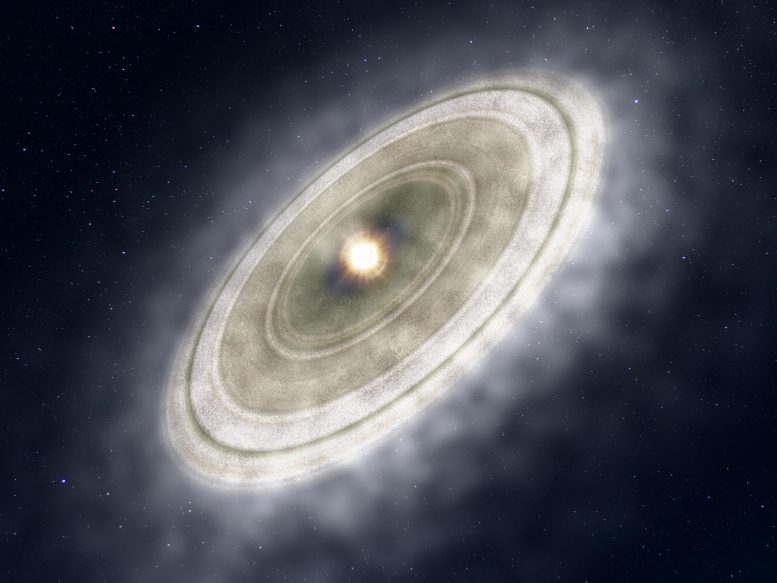
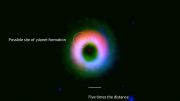
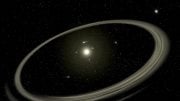

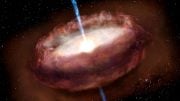
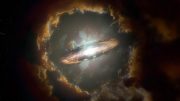
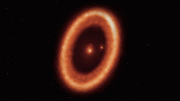
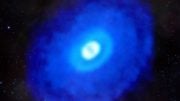

Be the first to comment on "Planet Formation Theory Questioned After Discovery of Massive Gas Disk Surrounding Young Star"